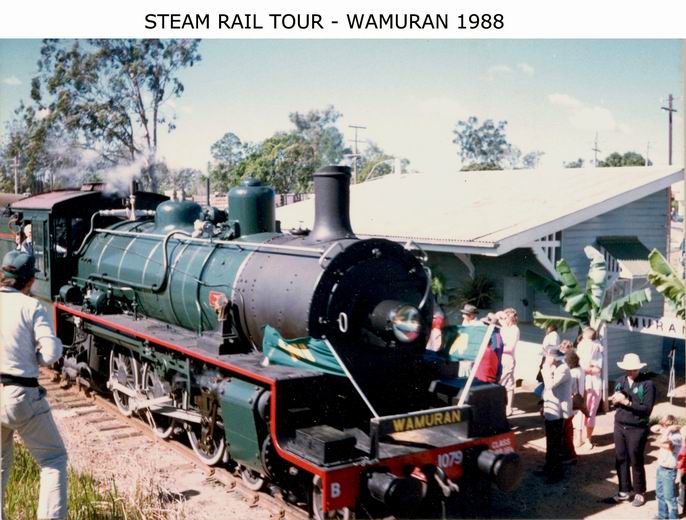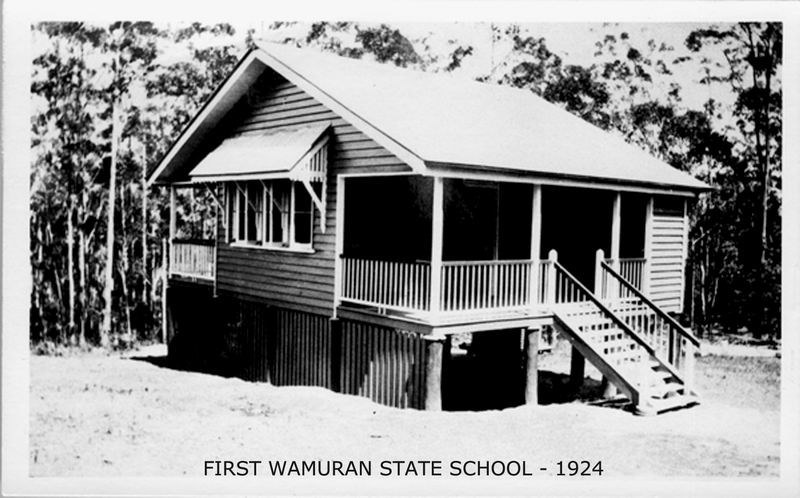
The Railway Line – Caboolture to Kilcoy.
As with many small towns being developed at the turn of the 20th century transport was a most important part of the infrastructure. Rail transport was needed to take timber to the mills, crops to the markets and to bring in food, mail and other necessary supplies. Pretty much everything needed to build a community was transported by rail in those early days.
On December 6th 1909, the railway line between Caboolture and Woodford was officially opened. Sidings were initially constructed at Moodlu, Wamuran, Bracalba, D’Aguilar and Woodford stations and later Zanow’s siding, [1910], and Attewell’s Siding [1913], were added to the inventory. By 1914 the line had been extended to Kilcoy and this opened up the area to further development by virtue of the direct contact now available to Caboolture and Brisbane. Regular freight and passenger trains plied the line and life became far more tolerable for the early settlers of the area.
The Railway line between Wamuran and Kilcoy was closed on 1st July 1964 but the section between Wamuran and Caboolture remained open for fruit and freight transport. The majority of the freight carried was pineapples destined for the Golden Circle Cannery at Northgate or cases of pineapples or bananas destined for the Markets in Brisbane or the Southern States. Rail ballast was transported from the Moodlu quarry to help build and maintain railway lines in the area, particularly the main north/south line north of Brisbane. In the 1970’s and 1980’s the Wamuran spur became very popular with day tripping steam train excursions and heritage trains and the line was used for large amounts of pineapple freight.
Train services on the last operating section of the line from Caboolture to Wamuran were finally suspended in September 1996, and the line was officially closed in September 2008. The original Wamuran Railway Station Building has now been relocated and is used by the Australian Narrow Gauge Railway Museum Society in Woodford.

The following section is an extract from a Blog by Mr. George McHugh and acknowledgement of his input is duly noted. Mr. McHugh gives a wonderful insight into the processes behind the rail service to the area and what went on behind the scnes.
I was a
fireman in the Queensland
Government Railways when the Branch line from Caboolture continued to Kilcoy. I
was fortunate in the fact that both of the Drivers I had from when I was
classified as a fireman in 1956, to when the line closed in 1964, had both
signed for the Kilcoy Branch. Only about half of the Drivers at Mayne went to
Kilcoy as there were only 3 goods trains a week to operate.
Rail
motors operated the Branch with a couple of services to and from Brisbane each day. The
afternoon rail motor service from Brisbane
on Fridays was replaced by an engine and three carriages. This was to cater for
school children boarding in Brisbane
and going home for the weekend. When working this train, a sharp lookout was
needed when coming to suburban stations enroute to Caboolture. If there were
passengers to be picked up for the Kilcoy Branch, a member of the station staff
would wave a red flag to stop the train and allow the intending passengers to
board.
This
train returned on a Saturday morning. The locomotive would usually be a PB15,
number 606 was a regular, or C16 number 642. (This C16 is the only one I know
of with the headlight in the Centre of the smoke box door). If you were really
lucky, you may score a C17 when they could spare one from other duties. The
students wishing to return to Brisbane
for Monday morning would catch a rail motor around 3pm from Kilcoy on Sunday
afternoon which terminated at Caboolture. They would then await the Mail Train
from Gympie, ‘112 up’, and travel to Brisbane
on this service.
My first
trip to Kilcoy was on the Friday afternoon service, ‘9 down’ with PB15 606 and
Driver Dan Gilvarry. From what I recall, you would sign on at Mayne about 2.50 pm,
leave Central about 4.10 pm and arrive at Kilcoy about 7.10 pm. After parking
the train, you would take the loco to the water tank, stable the loco and
retire to the quarters shared by the engine crew and guard. I think departure
from Kilcoy the next morning was about 7.40 am, arriving at central about 3
hours later. On an average, I probably had a trip to Kilcoy about once every 3
to 4 months. The goods train, ‘195 down’ returning as ‘196 up’ ran every
Tuesday, Thursday and Sunday nights always with a C17 loco. You would sign on
at Mayne at 5.40 pm, prepare the engine and then proceed to Mayne Yard to pick
up your train. The make up of the Train would be mainly empty box wagons, empty
“H” wagons for fruit and empty “S” wagons for logs and sawn
timber. These wagons would be dropped off at stations on the branch for loading
which would be picked up the next afternoon. 195 Down was timed to be in Kilcoy
about 1.00 am; giving you about 9.5 hours work for the trip after shunting
Kilcoy yard and stabling the loco.
The next
morning, you would usually go shopping up town and buy some fresh bread and
steak or sausages in preparation for the return trip. The fireman would book on
duty 2 hours ahead of the driver to light up the loco and raise steam. I don’t have a 1950’s goods timetable (which I would
love to get) but I think we left Kilcoy about 3.15 pm. We would then pick up
the loaded wagons (which we had left the night before) at most stations on the
way back. At Woodford, you would usually have finished your shunting before the
arrival of the Kilcoy bound rail motor. The rail motor was always crossed at
Woodford. Woodford was the biggest shunting yard after leaving Kilcoy, there
being 2 sawmills which loaded timber, plus a goods shed road for general
loading, a private siding and a cattle yard siding.
From
D’Aguilar in, most of the loading was fruit which would either be left at
Zillmere along with logs for Brandon’s at Virginia or dropped off
at Northgate Cannery on the way through. On arrival at the home signal for
Caboolture off the branch, the signal would usually be at Danger and the
Fireman would ring in telling Caboolture that we had arrived. It was not uncommon
to wait there for an hour as the main line was fairly busy around 7 or 8 pm and
nobody wanted to know about the train off the branch. Time worked for the trip
averaged about 11 or 12 hours.
I had
one occasion when I worked a stock train special to Winya, just before Kilcoy,
with Driver Bill Weiff with C17 loco 723 on Saturday 1st September 1956 at 1.25
am, after unloading the cattle, we had to proceed to Kilcoy for water and turn
the engine, reverse the guards van etc. We then had to pick up loaded wagons
from Kilcoy and finished up with a full load, approx 425 ton from Woodford. We
requested a relief crew to meet us at Caboolture, which luckily they did, and
we travelled home spare; on the same train. That job took 16.5 hours.
There
was a ballast pit at Moodlu, about 3.25 miles from Caboolture, and empty
ballast trains frequently ran to there from Mayne. As there were no turning
facilities at Moodlu, you would usually turn the engine at Caboolture on the
way out. As well as bringing wagons of ballast out of the pit, you would often
bring out a couple of “H” wagons of larger rocks (used on the sides
of cuttings to stop erosion.)
In the
latter years we used to work a passenger train, 239, from Central to
Caboolture, park the coaches in Caboolture yard and pick up a guards van and
work to Wamuran to pick up loaded wagons of fruit.
Once
again you would turn the engine at Caboolture on the way out, but often, with
the OK from the guard, you would set off with the guards van leading to save an
extra shunt at Wamuran.
This
arrangement happened after dark, but even if you had the loco leading, tender
first, you had no headlight on the rear. This could be a bit worrying as you
had numerous small road crossings across the track en route to Wamuran.
I
enjoyed working to Kilcoy before they closed the line as you would get away
from the rat race for a day or two.
George
McHugh
Copyright © WHVC 2012
